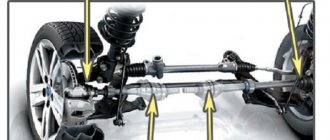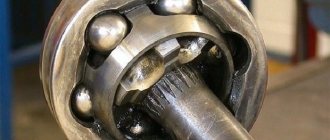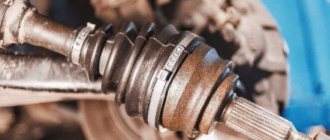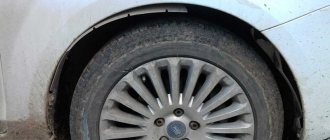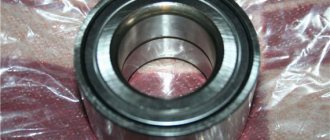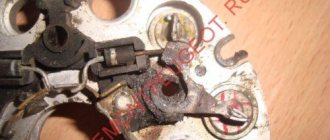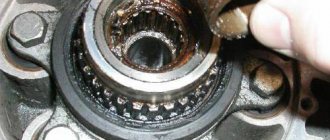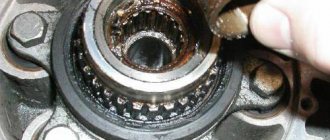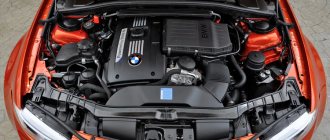The drives of the steered wheels of a car are a combination of two constant velocity joints (CV joints) connected by a shaft with splined ends. Strictly speaking, a similar design is found in the rear drive axle with a gearbox in a separate housing, but diagnostics are much more often required by the front drive, which operates in more severe conditions in terms of torque transmission angles.
The process of determining which of the four CV joints working there is worn out or has begun to deteriorate is usually difficult and requires adherence to a precise methodology in order to avoid wasted time and money.
Outer and inner CV joints: differences and features
The external joint is considered to be connected to the wheel hub, and the internal one is located on the output side of the gearbox or drive axle gearbox.
Both of these units differ in design, which is due to the requirements placed on them:
- during operation, the drive assembly must change its length as the suspension moves from one extreme vertical position to another, this function is assigned to the internal hinge;
- ensuring the maximum angle of rotation of the front wheel is carried out by the outer CV joint, which is provided for during its design;
- the external splines of the outer “grenade” end with a threaded part onto which a nut is screwed, tightening the inner races of the wheel bearing;
- the splined end on the inside of the drive may have an annular groove for a retaining ring, or have a loose fit; the shaft is retained in the crankcase by other means;
- the internal hinge, due to its small deviations in angle, is sometimes made not according to the classic six-ball design, but in the form of a tripoid, that is, three spikes and needle bearings on them with spherical outer races, this is stronger, more durable, but does not work well at significant angles.
Otherwise, the units are similar, both consist of a housing with grooves for balls or spikes, an internal race, splines sitting on the drive shaft and a separator that positions the balls when rolling the working grooves.
Identifying a specific faulty joint
Since a front-wheel drive vehicle has four CV joints, it is important to isolate the problem and determine which one requires replacement or, at a minimum, lubrication. Many people do not know how to do this, although in many cases everything turns out to be not so difficult.
First of all, of course, you should do a visual inspection. If the boot is damaged, then the CV joint definitely requires, at a minimum, dismantling, maintenance, lubrication and replacement of the protective rubber boot, and at maximum, replacement. Damage to the boot will be indirectly indicated by grease splashed on adjacent parts.
Try turning the hinge around the axis by hand. A serviceable CV joint should remain stationary. If there is play, then the hinge definitely needs to be replaced. However, it will be more reliable to determine the presence or absence of play by dismantling the axle shaft with grenades and holding it in a vice.
Causes and symptoms of constant velocity joint malfunction
The main reason for joint failure is wear of the grooves of both races, the separator and the balls. This can happen naturally, that is, in the presence of high-quality lubricant, for a very long time, over hundreds of thousands of kilometers, or accelerated.
On the subject: What is a CV joint, principle of operation, design and possible breakdowns
Rapid wear begins when abrasives or water get inside the protective elastic cover. With such a lubricant additive, the unit lives a thousand kilometers or less. Then the first signs of trouble begin to appear.
When rolling the balls, both races are in precise interaction with minimal gaps. The rolling and sliding trajectories are precisely calibrated, often even through selective selection of parts. Such a hinge operates silently when transmitting any calculated torque and at any angles from the designated range.
As soon as the gaps have increased due to wear or the geometry of the grooves has become distorted, knocks appear in the hinge due to the selection of backlashes and crunches due to local wedging. The transmission of torque occurs with jerks of varying degrees of noticeability.
Production of rolling balls
Most often, this is either a consequence of damage to the boot and the problems described above, or simply aging of the metal due to high mileage. It is manifested by the appearance of extraneous sounds from the suspension, clicks in turns, microvibrations and jerky starts. It can only be eliminated by replacing the mechanism. It is worth noting that a faulty CV joint can lead to damage to the mating components, so you should not put off replacing it for long.
How to check the outer CV joint
The most difficult condition for the external part of the drive will be the transmission of large torque at a maximum angle. That is, if the hinge is worn out, then the maximum value of play and acoustic accompaniment will be achieved precisely in such modes.
Hence the identification technique:
- when driving at low speed, the wheels are turned all the way to the extreme position and a sharp acceleration is performed, a crunch will be heard from the side of the faulty CV joint;
- by repeating the procedure in both directions, the conclusions are clarified, keeping in mind that the angle of rotation of the inner wheel relative to the trajectory is greater than that of the outer one;
- if in doubt, the car is hung on a lift, all these actions are repeated, and the diagnostician located under the car listens to specific components, the required load is simulated by simultaneously pressing the accelerator and brake pedals.
The final diagnosis is made after removing the drive from the machine and disconnecting the hinges from it. The backlash will be clearly visible when the outer race is rocked relative to the inner one, the wear of the grooves is visible after disassembly and removal of lubricant, and cracks in the cage are clearly visible on its hardened surface.
Diagnostics
To ensure that you avoid problems with a CV joint that pops out while driving, it is necessary to carry out diagnostic work in a timely manner. At least once a month, inspect the condition of the boot; if it is damaged, be sure to correct this problem. Failure detection is carried out as follows:
- A common method is to start with the wheels turned out
. To carry out such diagnostics, you will need to turn the wheels and start sharply from a place. The presence of a specific crunch will mean problems with the CV joints; - Raise the wheel on a jack, ideally you should use a lift, but garages usually don't have them. Then we inspect the CV joint; there should be no visible damage on it. Also try moving the wheel. The hinge should not have any play;
- This method is more complicated, but quite reliable. The front of the car is hanging out. First gear is engaged, if you have an automatic transmission, select mode
– D. Start the engine and listen to the wheels. They should not make even the slightest crunch.
Actually, this is all that can be done for diagnosis. It should be noted that this process at service stations is completely identical to the methods described.
Checking the internal grenade
When checking the internal hinge while moving, it is also necessary to create the worst operating conditions for it, that is, maximum angles. Nothing depends on turning the steering wheel, so you will need to tilt the car as much as possible, moving in an arc at high speed under full traction.
A crunch from the inside of the car relative to the trajectory will mean wear of the internal joint on this particular drive. The opposite side, on the contrary, will reduce the angle of the fracture, so a crunch there can only appear from a node that is in a completely critical condition.
A test on a lift can be constructed in approximately the same way, loading the drive with brakes, and changing the angles of the suspension arms using hydraulic supports. At the same time, it’s quite easy to assess the presence of gaps and the condition of the covers. Long torn boots with dirt and rust inside will mean that the hinge must definitely be replaced.
Necessary tool
Before replacing the VAZ 2114 inner CV joint boot, you should prepare all the necessary tools for this. For competent work you will need:
- Open-end wrenches for 17, 19. But it is better to have a full set on hand;
- Set of heads and knobs;
- Wheelbrace and jack;
- Pliers;
- Screwdriver;
- Rag and gloves.
For ease of dismantling, you can drive onto a pit or overpass. Be sure to set the vehicle's parking brake or engage first gear. For greater safety, you can install supports under the wheels. Also, be sure to check that you have a complete replacement kit: grenade, boot, CV joint grease and two clamps.
Why is crunching dangerous?
A crisp hinge will not last long; such shock loads will destroy it at an increasing pace. The metal gets tired and becomes covered with a network of microcracks and pitting, that is, chipping of the working surfaces of the tracks.
A very hard, but at the same time fragile separator will simply crack, the balls will behave in an arbitrary manner and the hinge will jam. The drive will be destroyed and further movement of the car will only be possible on a tow truck, and loss of traction at high speed is also unsafe.
At the same time, it is possible that the operation of the gearbox, which has been subjected to impacts from the drive shaft, may be disrupted.
History of appearance
At the end of the 17th century, the famous scientist Hooke proposed using a cardan joint for rotation between shafts. At the same time, gimbals first began to be used in Ancient Greece. A hinge similar to the one that was invented several centuries ago is still used in automotive technology to this day. Its main disadvantage is the uneven transmission of rotation when angles arise between the shafts. The larger the angle, the stronger the vibration. In practice, a hinge is not always used to connect rotating shafts. Instead, springs and couplings are used.
The universal joint of the English scientist is present in most cars today. At a small angle of rotation, the imperfections of the hinge are invisible. Negative aspects began to appear with the advent of cars with steering wheel drive.
According to another version, CV joints were invented by the scientist Alfred Rzepp. This happened in 1927. After this, the part began to be called the “Rzepp hinge,” but over time the word “grenade” began to be used.
Is it possible to repair the CV joint or just replace it?
In practice, repair of a CV joint is impossible due to the high precision of its manufacture, which involves the selection of parts. A hinge assembled from disparate parts will be able to work somehow, but we can’t talk about noiselessness and reliability.
A worn-out assembly will have to be replaced as an assembly, since the splined joints on the shaft also wear out, after which the assembly will knock even with new hinges. But it is quite expensive, so it is offered only by original spare parts manufacturers.
Analogs can be supplied in the form of kits consisting of the CV joint itself, boot, metal clamps and special lubricant in the required quantity.
Torn boot
Probably the most common malfunction of one of the CV joint parts, which leads to breakdown of the entire mechanism, is damage to the boot. The latter comes in two types: rubber and thermoplastic. Rubber is noticeably cheaper, so it is mainly used in the low-cost segment. Thermoplastic anthers are noticeably more expensive, but they are much more durable and also withstand mechanical damage much better. Some car owners are suspicious of thermoplastic due to its rigidity, which is a misconception.
The three main enemies of the CV joint boot are external physical impact, frost and natural rubbing.
With frost, everything is clear: here you only need a high-quality composition of the anther material, which is not cheap. So if you buy a cheap component, you shouldn’t rely on its physical properties.
External damage most often occurs in all-wheel drive vehicles that often go off-road. Ideally, after each such trip, at least a visual inspection should be carried out.
Rubbing most often occurs when the CV joint turns and the ribs of the boot begin to touch each other. That is why, when replacing the boot, it is necessary to lubricate the inside with a special lubricant so that it does not rub dry.
There are such design features of the machines themselves (for example, domestic ones) when the CV joint is always in a bent state and the boot touches its internal metal parts. In addition, it happens that the boot is located near strong heating systems, such as the exhaust manifold, as a result of which it slowly melts.
A torn boot will not immediately manifest itself as a breakdown. If the lubricant is of high quality, it will lubricate all rubbing parts for quite a long time. So, if the damage is not revealed during diagnostics, then you can sometimes wait a month or even more for breakdowns and buzzing of the CV joint, since the lubricant in the mechanism itself lasts for quite a long time, but abrasive particles get into it, which accelerate wear.
In the event of loss of lubrication, the rubbing mechanisms begin to overheat, as a result of which the CV joint cage rotates and the front-wheel drive vehicle is left with virtually one drive wheel.
